
在Microsoft Sway中查看
主要功能
測量光合作用、蒸騰作用、呼吸作用、葉綠素熒光(可選)
氣體交換和熒光參數(shù)的光響應曲線和 CO2 響應曲線
同步測量 CO2 氣體交換與其它光合指標
測量參數(shù)
凈光合速率,呼吸速率,蒸騰速率,氣孔導度,胞間二氧化碳濃度,葉綠素熒光參數(shù)(可選)等
應用領域
植物生理、植物生態(tài)、農(nóng)學、林學、園藝學等。
全方位的PAR測量設計
GFS-3000 系統(tǒng)具備全方位的 PAR 測量設計:三個 PAR 傳感器(下圖紅圈部分),分別測量環(huán)境 PAR,葉室內(nèi)部葉片正面 PAR,以及葉室內(nèi)部葉片背面 PAR。本設計的優(yōu)點在于不會忽略葉片背面的光合作用測量。
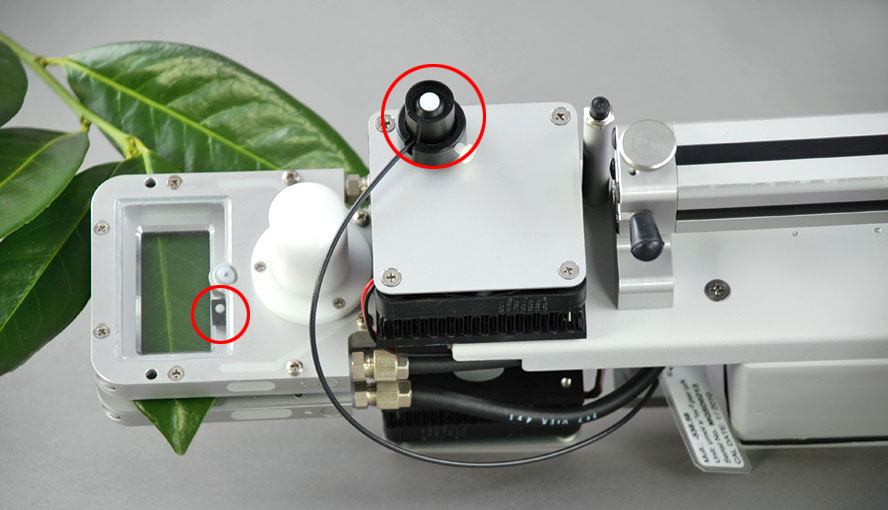 |  |
全方位的溫度測量設計
獨特的四溫度測量設計:
Tleaf:熱電偶,測量葉片溫度
Tcuv:Pt-100 熱敏電阻,測量葉室溫度
Tamb:Pt-100 熱敏電阻,測量環(huán)境溫度
Ttop:Pt-100 熱敏電阻,測量葉室上部溫度
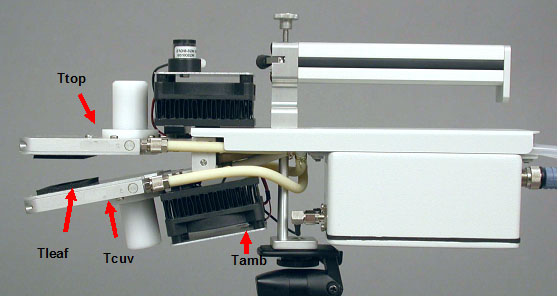 |
多種葉室可供選擇
GFS-3000 標準葉室的設計允許快速、簡便的更換各種滿足特殊需要的葉室。紅藍 LED 光源 3040-L 可與所有葉室連接使用。
標準葉室
適合多數(shù)葉片,標準測量面積 8 cm2,可更換配件滿足 1~12.5 cm2 的測量面積。
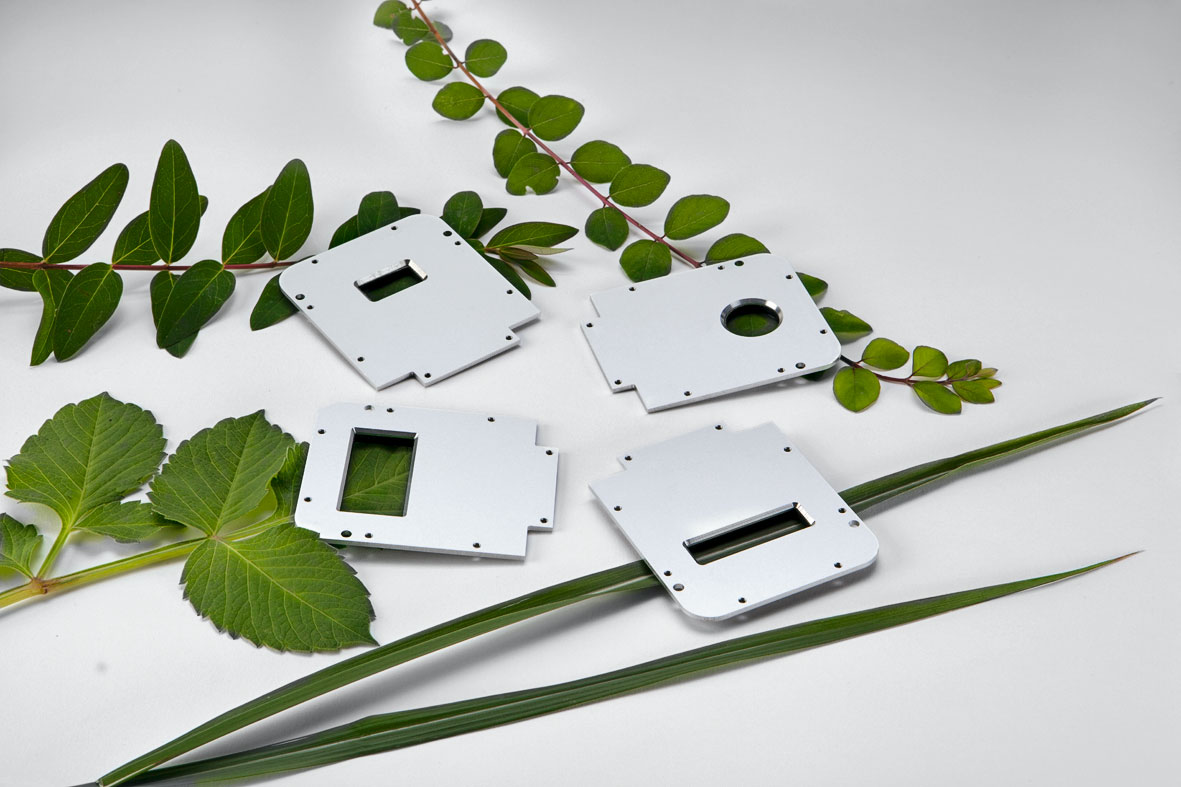 | 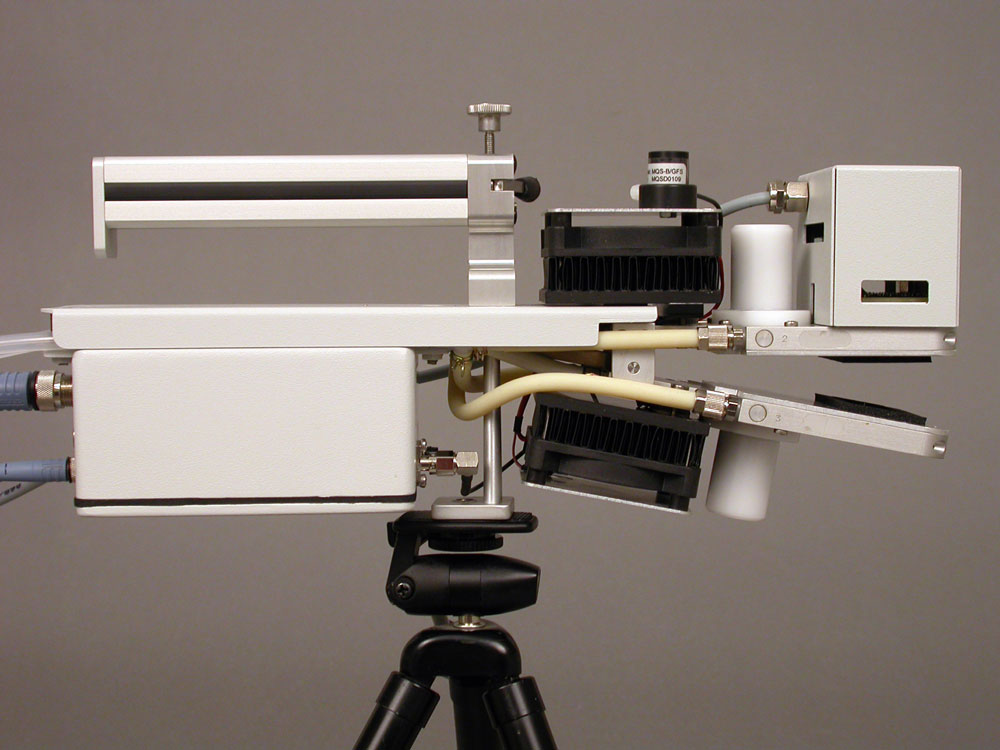 |
柱狀葉室
適合地衣、苔蘚、土壤樣品和小動物等。
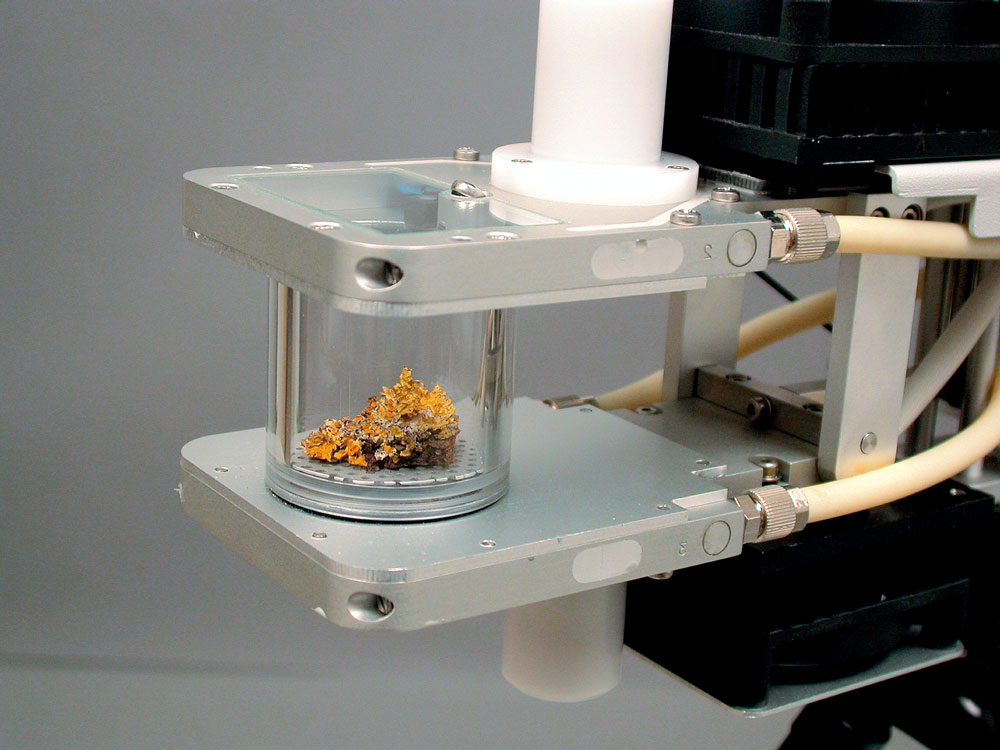 |  |
針葉葉室
適合各種針葉植物葉片或小枝條。
 | 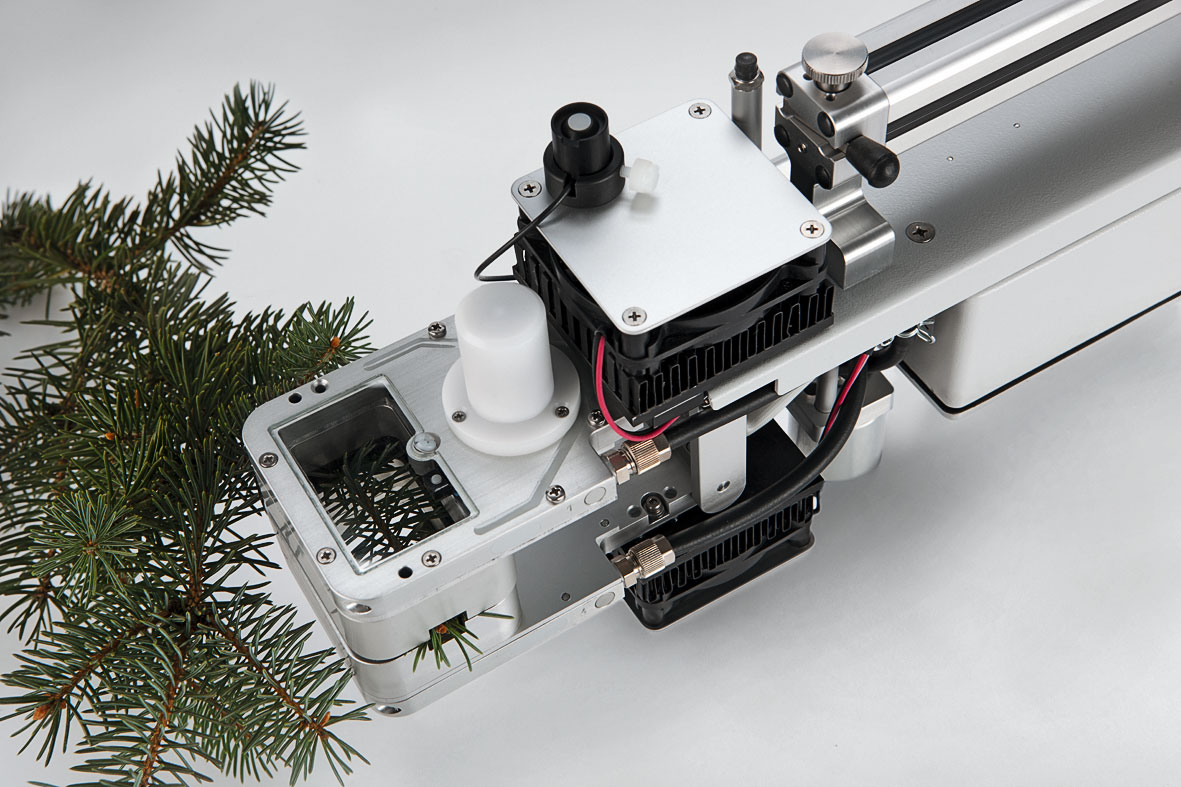 |
擬南芥植株葉室
大容積,可放進(盆)直徑 55 cm~70 mm 的盆栽擬南芥或其它小植株。
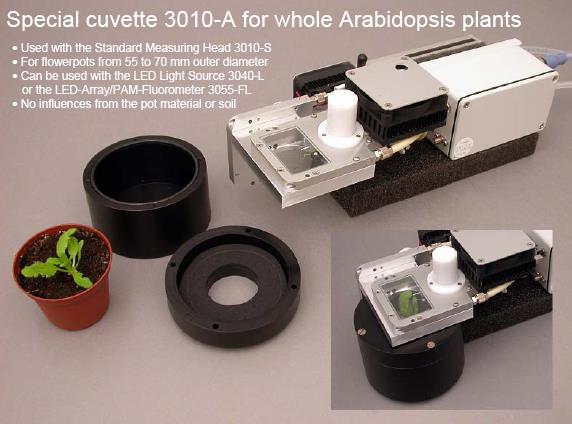 | 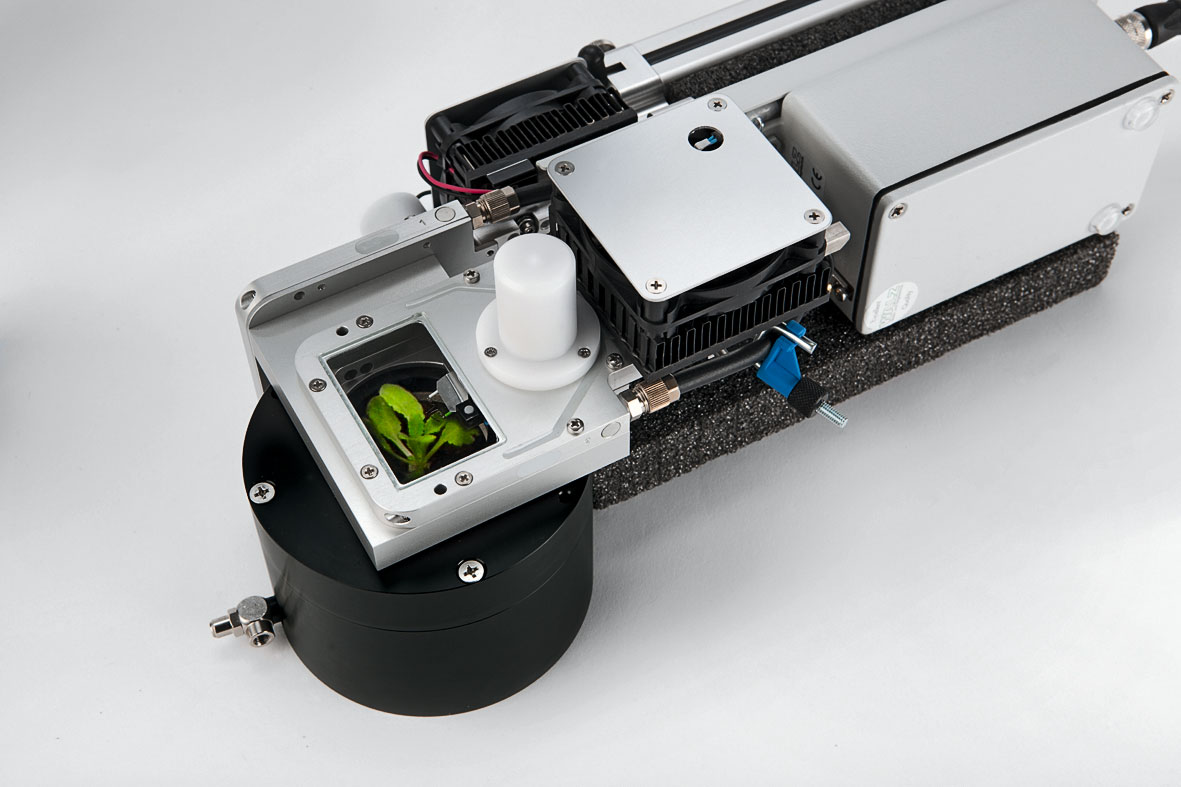 |
同步測量植物 CO2 氣體交換與其它光合指標的解決方案
光合作用是地球上重要的化學反應之一,是整個生物圈物質(zhì)循環(huán)與能量流動的基礎。測量生物的光合作用一直是科研界的熱點。
傳統(tǒng)的光合作用測量主要包括調(diào)制葉綠素熒光(PAM 技術)、CO2 氣體交換和光合放氧三大技術,幾十年來在國際科研界均得到了廣泛應用。由于調(diào)制葉綠素熒光和 CO2 氣體交換都可以做到無損、原位、活體測量,對同一個樣品可以進行長期的脅迫處理研究(光合放氧需要破碎葉片),因此應用更廣泛一些。
此外,還有一種差式吸收技術,可以通過測量光合組分在氧化還原(或加亞基、去亞基)過程中的差式吸收來反映他們的活性。如通過測量光系統(tǒng) I 反應中心葉綠素 P700 的差式吸收來測量光系統(tǒng)I的活性(DUAL-PAM-100),通過測量 P515/535 的差式吸收來測量跨膜質(zhì)子梯度 ΔpH 和玉米黃素(Zea)的變化(DUAL-PAM-100 的 P515/535 模塊),通過測量 500-570 nm 的差式吸收來測量 C550、Cyt b559、Cyt b563、Cyt c556、Cyt c6、Cyt f 等的活性變化(KLAS-100)。這種技術信號弱、難度高,但也具有無損、原位、活體測量的特點。隨著雙通道 PAM-100 測量系統(tǒng) DUAL-PAM-100 的大規(guī)模商業(yè)化生產(chǎn),差式吸收技術已在國際光合作用學界得到廣泛應用。
更加可喜的是,可以同步測量 C550、Cyt b559、Cyt b563、Cyt c556、Cyt c6、Cyt f、P515、Scatt(散射信號)、Zea(玉米黃素)等活性的動態(tài) LED 陣列差示吸收光譜儀 KLAS-100 也已研發(fā)成功,大大拓展了差示吸收技術在光合作用研究領域的應用。
除了利用上述幾種技術進行單獨測量外,從上世紀 80 年代后期,逐漸開始了兩種技術的同步測量,如同步測量調(diào)制葉綠素熒光與 CO2 氣體交換、同步測量調(diào)制葉綠素熒光與光合放氧等。
隨著技術的進步,有越來越多的指標可以同步測量,而且即使是兩種指標的同步測量(如調(diào)制葉綠素熒光與 CO2 氣體交換),也可以有多種測量模式可供選擇。
德國 WALZ 公司擁有 CO2 氣體交換、調(diào)制葉綠素熒光和差式吸收三種核心技術。為了方便廣大科研工作者更深入的了解各種光合作用的同步測量技術,澤泉生態(tài)開放實驗室(Zealquest Laboratory for Ecological Research)總結(jié)出了一套 CO2 氣體交換與其它光合指標的同步測量解決方案,希望能為相關單位提供參考。
方案功能與設備
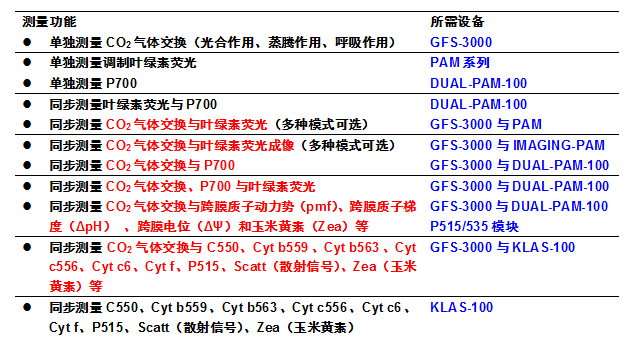 |
CO2 氣體交換與調(diào)制葉綠素熒光、差式吸收等技術的同步測量,有很多模式可供選擇。下面將根據(jù)技術難度從低到高的順序,分 5 方面進行介紹。
同步測量一:同步測量 CO2 氣體交換與葉綠素熒光
CO2氣體交換與葉綠素熒光的同步測量,主要有以下幾種模式:
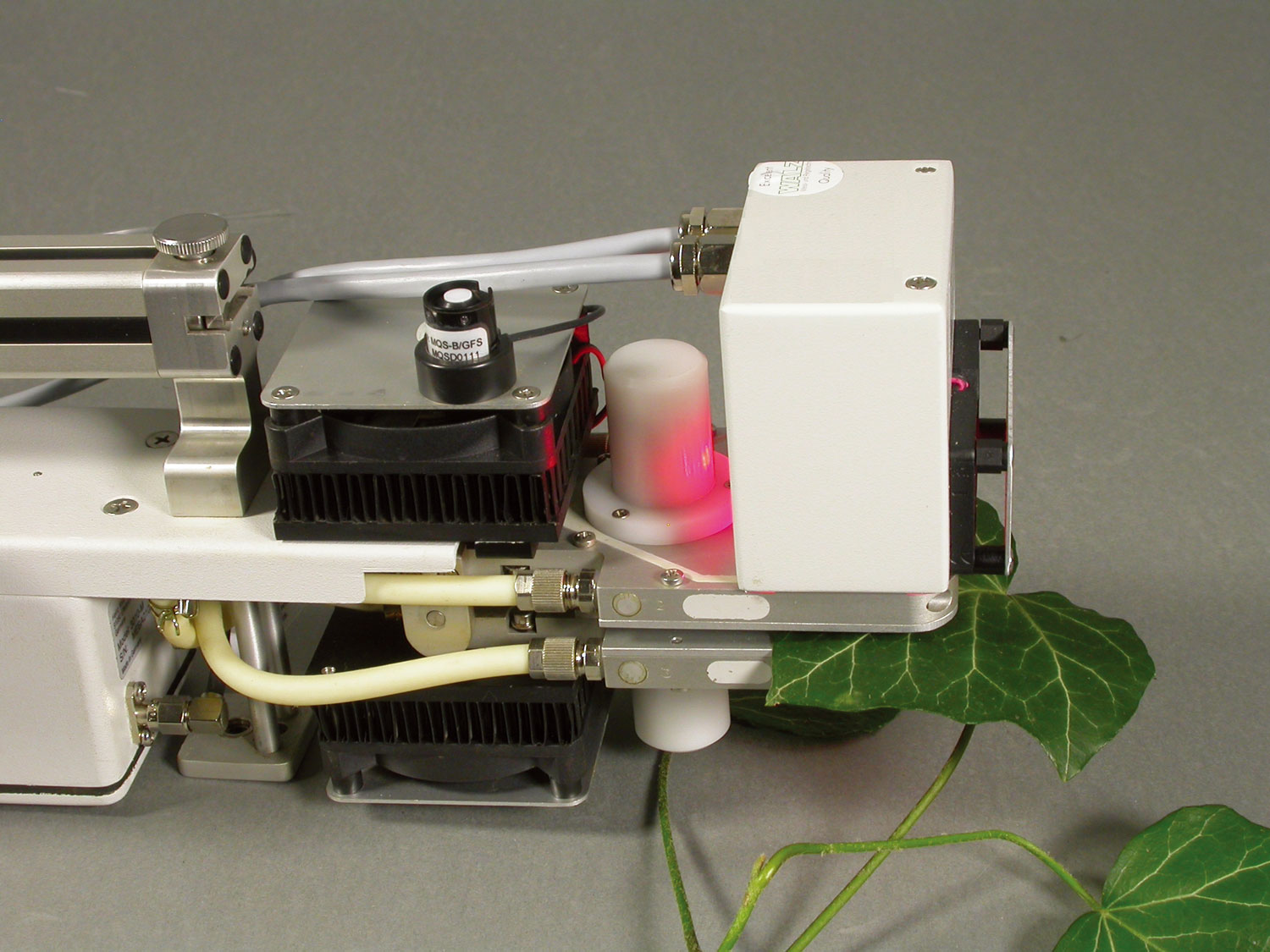 |  | |
| 模式一(GFS-3000/FL):便攜式光合儀 GFS-3000 連接熒光附件 3057-FL,在儀器提供的人工光下同步測量氣體交換與葉綠素熒光。3057-FL 不能單獨使用。 | 模式二(GFS-3000/F):便攜式光合儀 GFS-3000 連接熒光附件 3050-F,在自然光下或人工光下同步測量氣體交換與葉綠素熒光。3050-F 不能單獨使用。 | |
| | | |
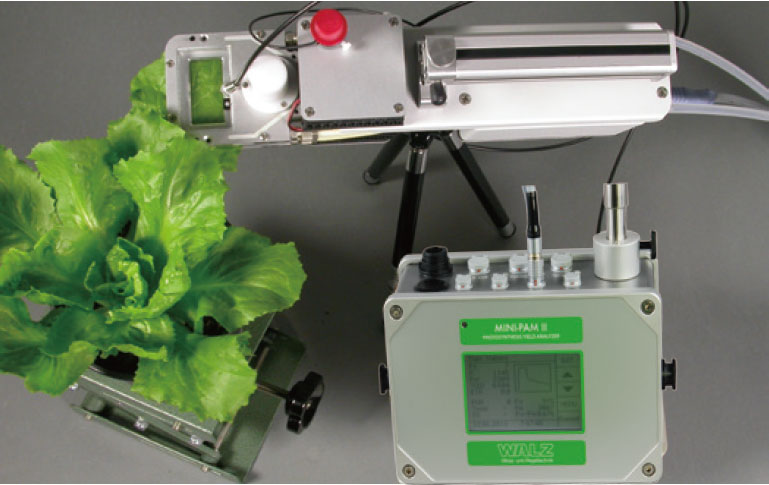 | 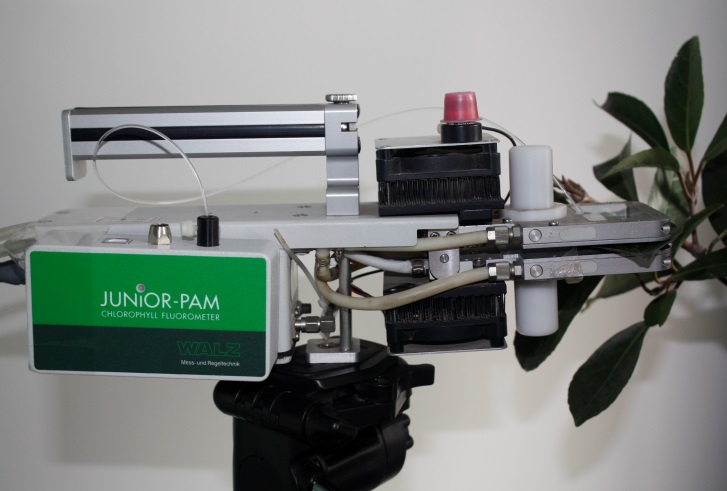 | |
| 模式三(GFS-3000/M):便攜式光合儀 GFS-3000 連接超便攜式調(diào)制熒光儀 MINI-PAM,在自然光下或人工光下同步測量氣體交換與葉綠素熒光。MINI-PAM 可單獨使用。 | 模式四(GFS-3000/J):便攜式光合儀 GFS-3000 連接基礎型調(diào)制熒光儀 JUNIOR-PAM,在自然光下或人工光下同步測量氣體交換與葉綠素熒光。JUNIOR-PAM 可單獨使用。 |
上述 4 種模式可以根據(jù)需要靈活選擇,特別是模式三,既可同步測量,也可分開測量。由于光合儀比較沉重,在許多條件苛刻的場合就可以攜帶極便攜的 MINI-PAM 進行測量。
同步測量二:同步測量 CO2 氣體交換與葉綠素熒光成像
CO2 氣體交換與葉綠素熒光成像的同步測量,主要有一下幾種模式【技術文獻見“代表文獻”部分】。
模式一:與 MINI-IMAGING-PAM 聯(lián)用 測量面積 2 x 3.2 cm | 模式二:與 MAXI-IMAGING-PAM 聯(lián)用 測量面積 10 x 13 cm | |
 | 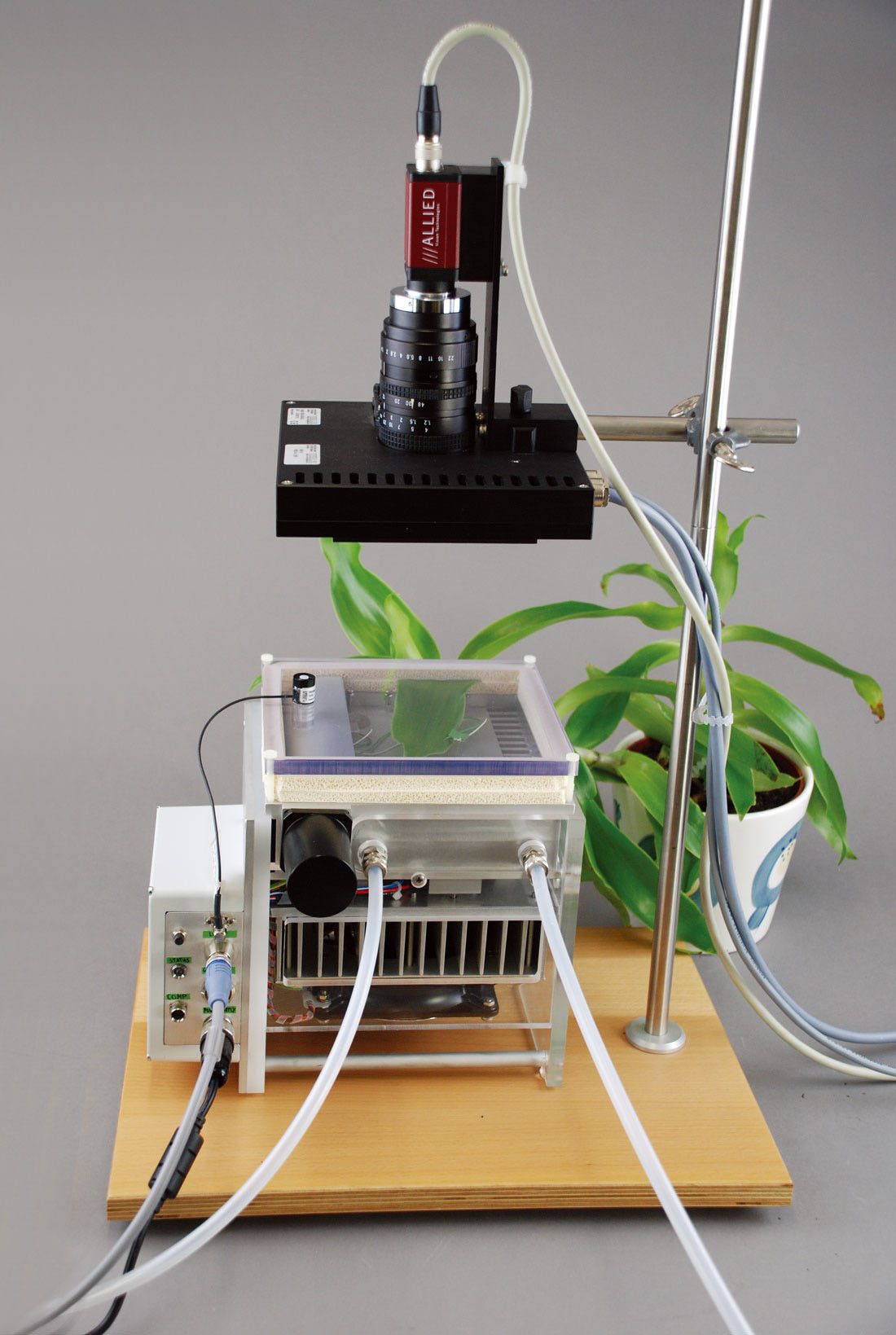 | |
GFS-3000/IM-MINI 連接標準測量葉室,適合大多數(shù)樣品測量。 | ||
| | ||
 | ||
GFS-3000/IM-MINI-Arabidopsis 連接擬南芥整株葉室,適合小植株的整株測量。 | GFS-3000/IM-MAXI 連接特制大葉室,適合大型葉片的測量。 |
由于 M 系列 IMAGING-PAM 可以共用一個主機分別連接多個測量面積不同的探頭(MAXI-,MINI-,MICROSCOPY-),而 GFS-3000 又有多種葉室可供選擇,這就極大豐富了同步測量 CO2 氣體交換與葉綠素熒光成像的模式。如分別與 IMAGING-PAM 的 MAXI- 和 MINI- 探頭連接,就可在不同的測量面積上同步測量。另外,與擬南芥整株葉室結(jié)合,就可測量小植株的整株氣體交換和熒光成像。
GFS-3000 設計的一個重要特點就是,標準葉室、柱狀葉室、針葉/簇狀葉室、擬南芥整株葉室的上表面是相同的,都可以與 MINI-IMAGING-PAM 結(jié)合使用,更進一步擴大了同步測量的應用范圍。
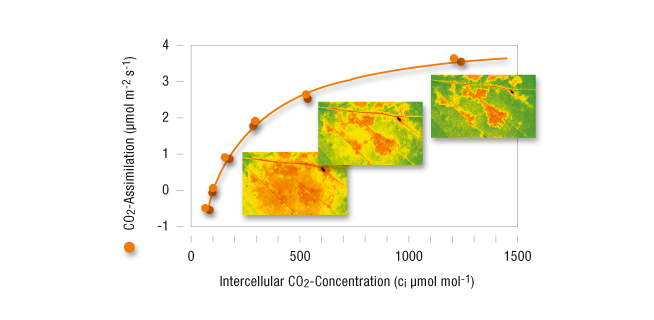 |
同步測量三:同步測量 CO2 氣體交換、P700 與葉綠素熒光
光合儀 GFS-3000 與 DUAL-PAM-100 測量系統(tǒng)聯(lián)用,完美實現(xiàn)了氣體交換、葉綠素熒光與差式吸收同步測量。同步測量 CO2 氣體交換與 葉綠素熒光和P700 。
系統(tǒng)組成
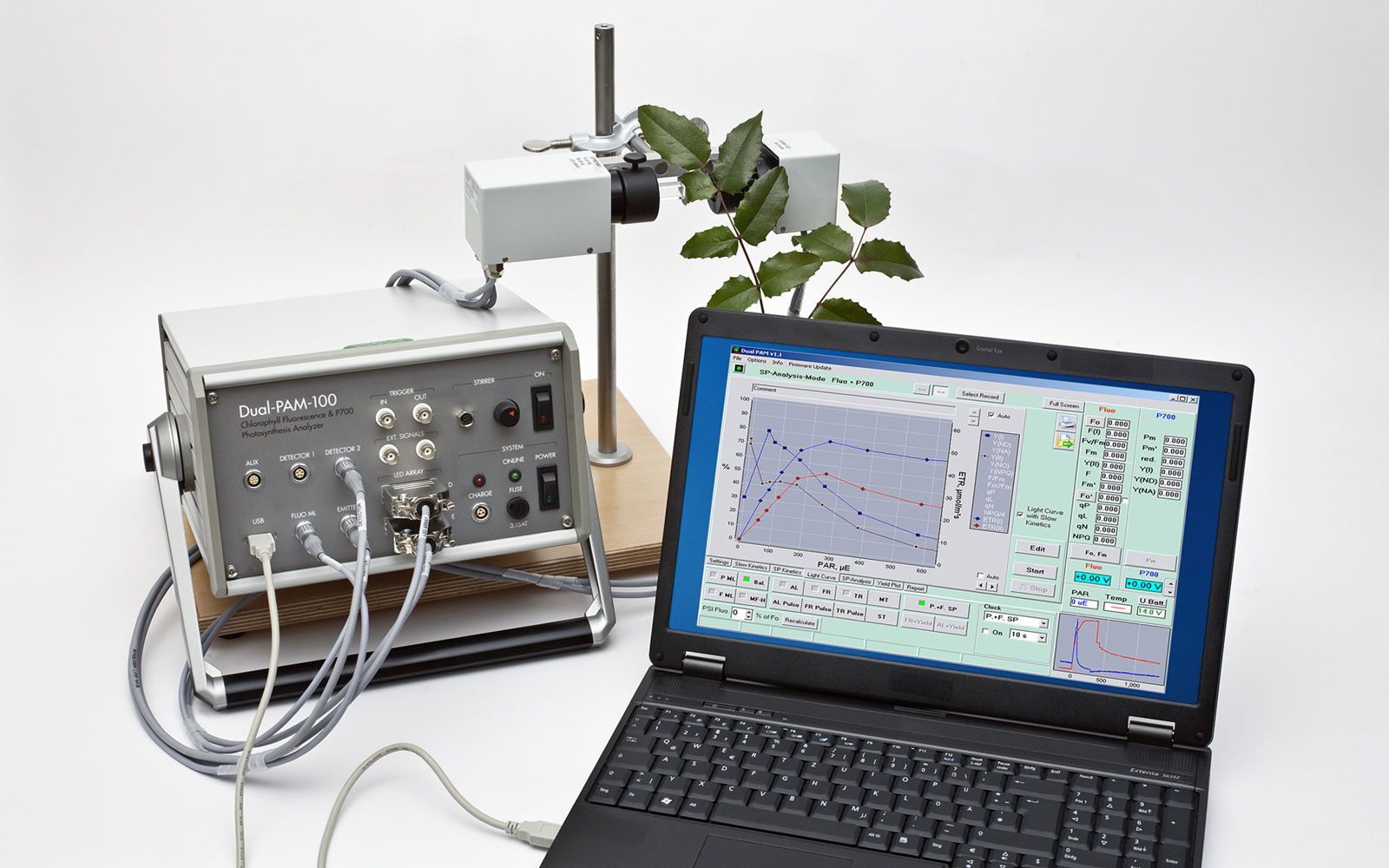 | 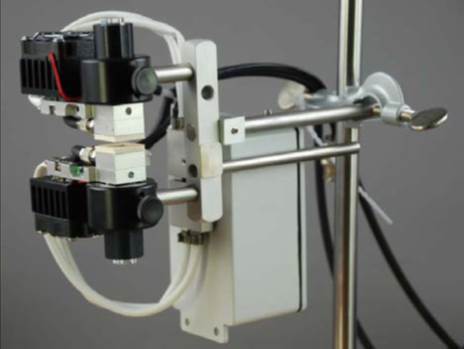 | 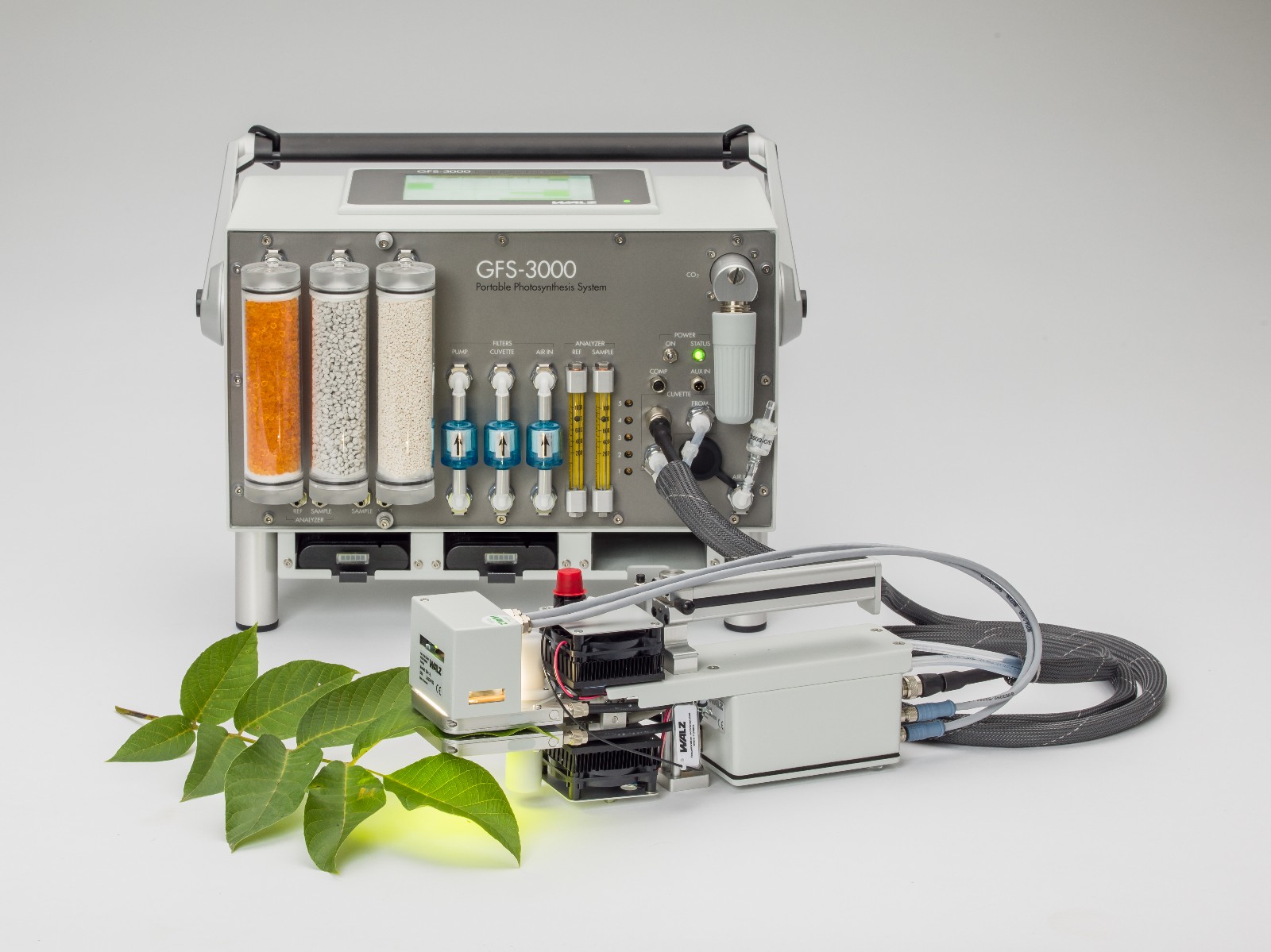 |
| DUAL-PAM-100 | 3010-DUAL | GFS-3000 |
 | ||
| GFS-DUAL | ||
主要功能
同步測量 P700、葉綠素熒光與氣體交換
同步測量 P700、葉綠素熒光與氣體交換的暗-光誘導曲線
同步測量 P700、葉綠素熒光與氣體交換的光響應曲線和 CO2 響應曲線
典型的氣體交換測量,如光合作用、蒸騰作用、呼吸作用
典型的葉綠素熒光測量,如誘導曲線、快速光曲線、淬滅分析、暗馳豫等
典型的 P700 曲線測量
葉綠素熒光與 P700 的快速誘導動力學等
編程進行復雜的同步或獨立測量
測量參數(shù)
PS II 參數(shù):Fo, Fm, F, Fm’, Fv/Fm, Y(II), Fo’, qP, qL, qN, NPQ, Y(NPQ), Y(NO) 和 ETR(II) 等
PS I 參數(shù):P700, Pm, Pm’, P700red, Y(I), Y(ND), Y(NA) 和 ETR(I) 等
氣體交換參數(shù):參比室和樣品室的 CO2 絕對值(CO2abs,CO2sam),參比室和樣品室的 H2O 絕對值(H2Oabs,H2Osam),流速(gas flow),環(huán)境氣壓(Pamb),葉室溫度(Tcuv),葉片溫度(Tleaf),環(huán)境溫度(Tamb),環(huán)境 PAR(PARamb),葉室內(nèi)葉片正面 PAR(PARtop),葉室內(nèi)葉片背面 PAR(PARbot),葉室相對濕度(rH),蒸騰速率(E),水氣壓飽和虧(VPD),葉片氣孔導度(GH2O),凈光合速率(A),胞間 CO2 濃度(Ci),環(huán)境 CO2 濃度(Ca),植物水分利用效率,CO2 響應曲線,光響應曲線等
DUAL-PAM 氣體交換葉室——3010-DUAL
 | 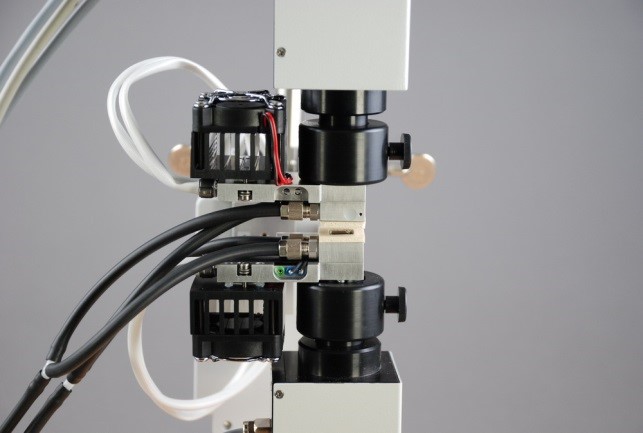 |
| 3010-DUAL | 3010-DUAL 與 DUAL-PAM-100 的測量頭連接 |
專為 DUAL-PAM-100 與 GFS-3000 的同步測量設計,由特制葉室(帶溫度和 PAR 傳感器)、風扇、導光桿、電子盒與支架構成。同步測量時,光源完全由 DUAL-PAM-100 的測量頭提供,氣體交換由 GFS-3000 的紅外分析器檢測,P700和葉綠素熒光由 DUAL-PAM-100 的檢測器測量。
需要注意的是,3010-DUAL 可以連接 DUAL-PAM-100 的 DUAL-DB 測量頭,但不能連接 DUAL-DR 測量頭。DUAL-DR 的光學單元太復雜,連接 3010-DUAL 容易損傷 DUAL-DR。
測量實例
下面的兩個圖是以洋常春藤(Hedera helix)為材料,利用本系統(tǒng)同步測量的 P700、葉綠素熒光和氣體交換的誘導曲線。
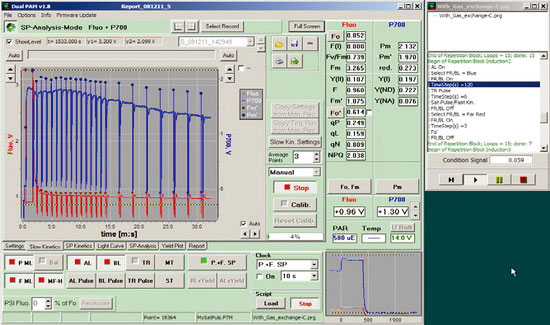 |
| 洋常春藤(Hedera helix)的 P700(藍色)和葉綠素熒光(紅色)的誘導曲線 |
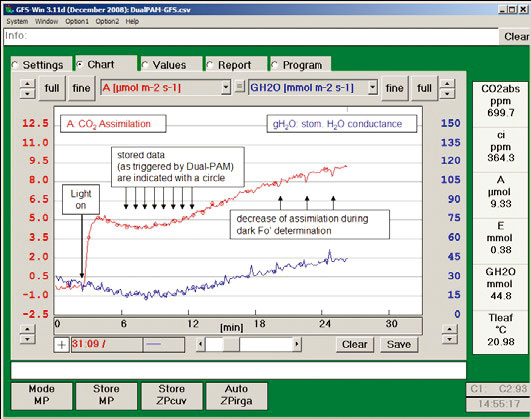 |
| 洋常春藤(Hedera helix)的凈光合速率(紅色)和氣孔導度(藍色)的誘導曲線 |
同步測量四:同步測量 CO2 氣體交換與跨膜質(zhì)子動力勢(pmf)、跨膜質(zhì)子梯度(ΔpH) 、跨膜電位(ΔΨ)和玉米黃素(Zea)
P515/535 模塊是 WALZ 公司為 DUAL-PAM-100 設計的測量模塊,可以直接連接 DUAL-PAM-100 的主機,測量 550-510 nm 的差式吸收以及 535 nm 波長的信號變化。P515/535 模塊可以測量光合器官的跨膜質(zhì)子動力勢(pmf)、跨膜電位(Δψ)、跨膜質(zhì)子梯度(ΔpH)和玉米黃素(Zea)變化等內(nèi)容。此外,該模塊還提供一種特殊的 “P515 Flux” 操作模式,可讓光化光以光-暗脈沖形式打開-關閉(1/1調(diào)制光/暗),原位測量活體樣品處于穩(wěn)態(tài)的偶聯(lián)電子和質(zhì)子的流動速率。
GFS-3000 通過專用氣體交換葉室 3010-DUAL 與 DUAL-PAM-100 以及 P515/535 模塊聯(lián)用后,做到了同步測量 CO2 氣體交換與跨膜質(zhì)子動力勢(pmf)、跨膜質(zhì)子梯度(ΔpH) 、跨膜電位(ΔΨ)和玉米黃素(Zea)。由于 ΔpH 和 Zea 都與葉黃素循環(huán)密切相關,而葉黃素循環(huán)是植物光保護的重要調(diào)節(jié)機制,再結(jié)合氣體交換指標反映的 Calvin 循環(huán)狀況,就可以非常深入的對植物光保護調(diào)節(jié)機制進行研究。
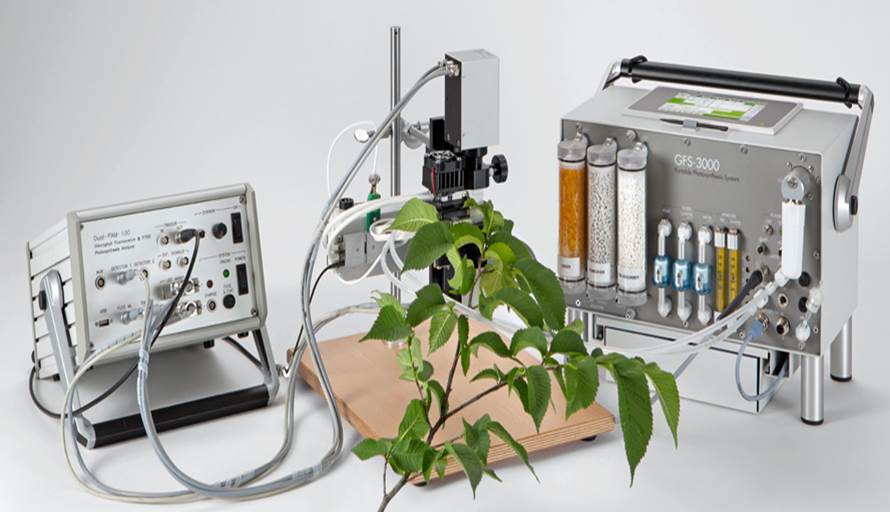 | ||
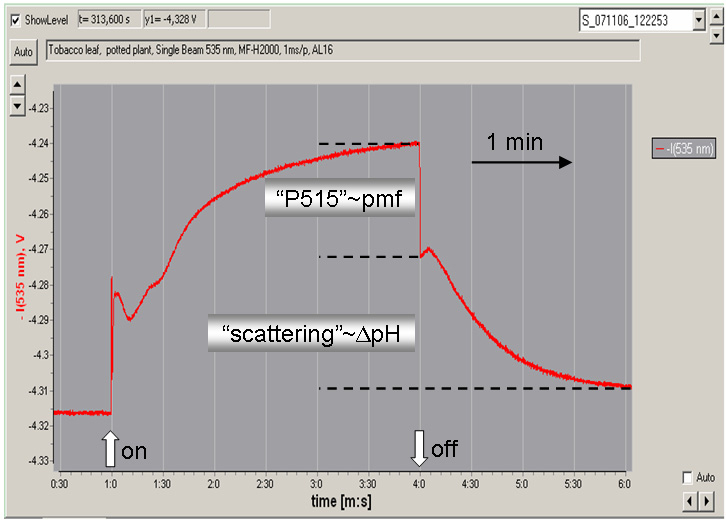 |  | 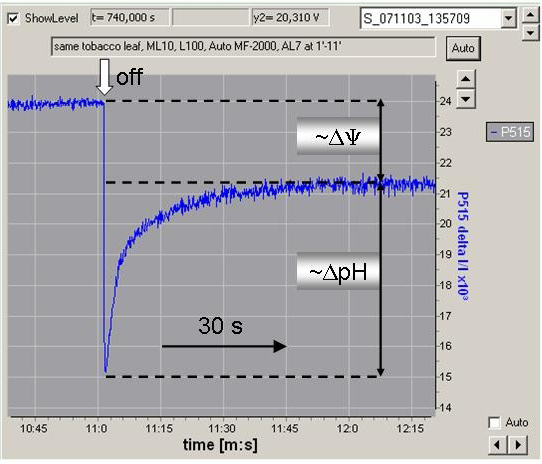 |
| DUAL-PAM-100 P515/535 與 GFS-3000 聯(lián)用 | ||
同步測量五:同步測量 CO2 氣體交換與 C550、Cyt b559、Cyt b563、Cyt c556、Cyt c6、Cyt f、P515、Scatt(散射信號)、Zea(玉米黃素)
傳統(tǒng)的差式吸收技術每次只能測量一個組分的差式吸收變化,而光合機構特別復雜,很多組分是偶聯(lián)在一起發(fā)揮作用的,幾種組分分開測量的結(jié)果難以完美表征它們在偶聯(lián)的功能體下的實際作用機制。
Schreiber 教授花費 20 年時間研制的動態(tài) LED 陣列差式吸收光譜儀 KLAS-100 完美的解決了上述缺陷。它采用 500-570 nm的差示吸收光譜技術來同步測量光合膜上 C550、Cyt b559、Cyt b563、Cyt c556、Cyt c6、Cyt f、P515、Scatt(散射信號)、Zea(玉米黃素)等8種組分的氧化還原變化。
著名的 DUAL-PAM-100 測量系統(tǒng)只有兩個測量通道,而 KLAS-100 有 10 個測量通道。因此,1 臺 KLAS-100 相當于 5 臺 DUAL-PAM-100 的功能。
GFS-3000 通過 3010-DUAL 專用氣體交換葉室與 KLAS-100 聯(lián)用后,做到了同步測量 CO2 氣體交換與 C550、Cyt b559、Cyt b563、Cyt c556、Cyt c6、Cyt f、P515、Scatt(散射信號)、Zea(玉米黃素)。
這些測量指標結(jié)合在一起,可以進行非常復雜的、前人未做過的深入研究。KLAS-100 是剛剛發(fā)展成熟的一種技術,在著名的《Plant Physiology》上發(fā)表了兩篇文獻。
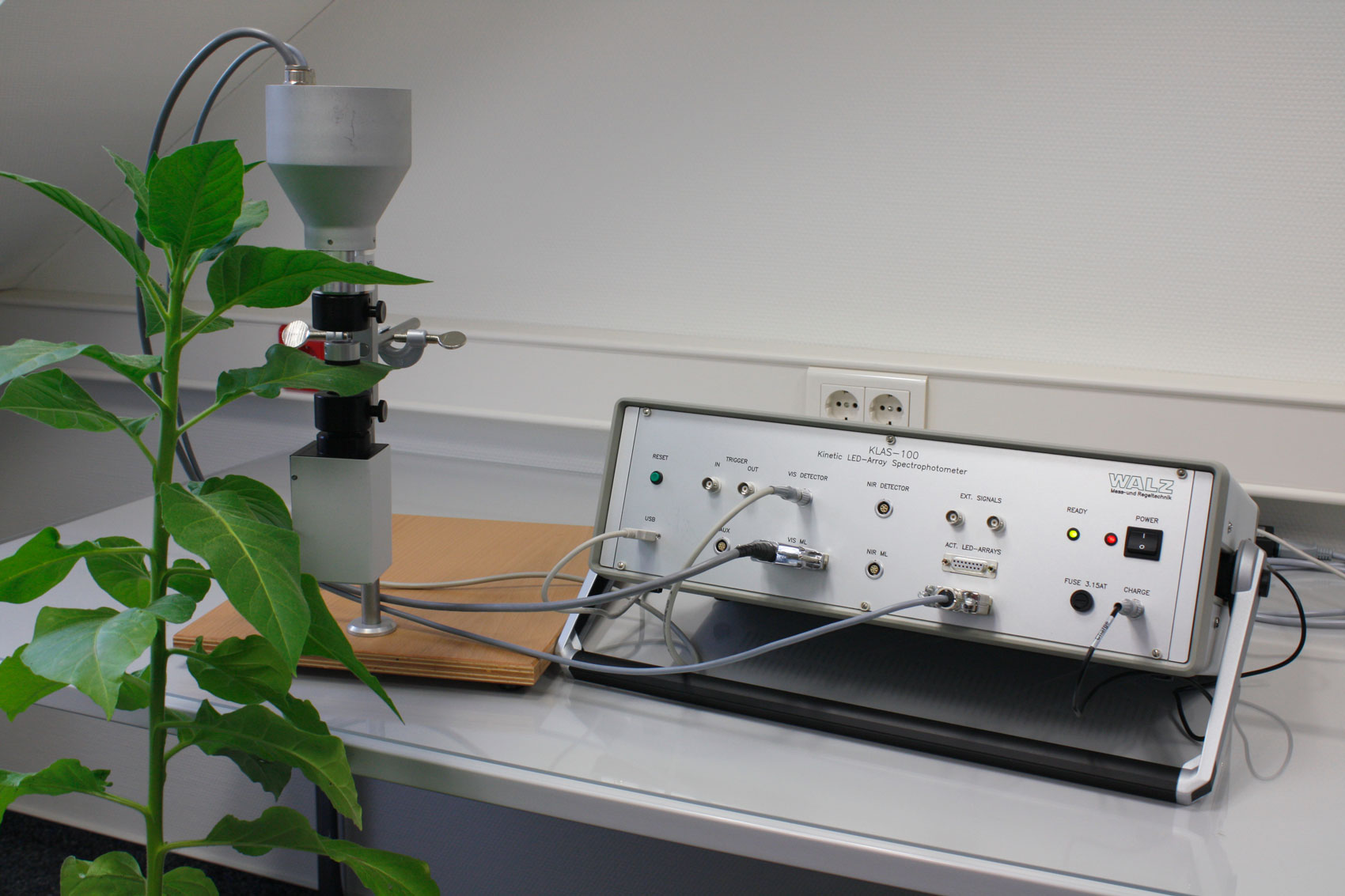 |
| KLAS-100 |
同步測量技術選購指南
利用 GFS-3000 與其它技術(調(diào)制葉綠素熒光、差式吸收)的聯(lián)用,可以實現(xiàn)多種光合指標的同步測量,利用無損、原位、活體的測量進行非常復雜、深入的機理性研究。下表是實現(xiàn)這些測量功能的選購指南:
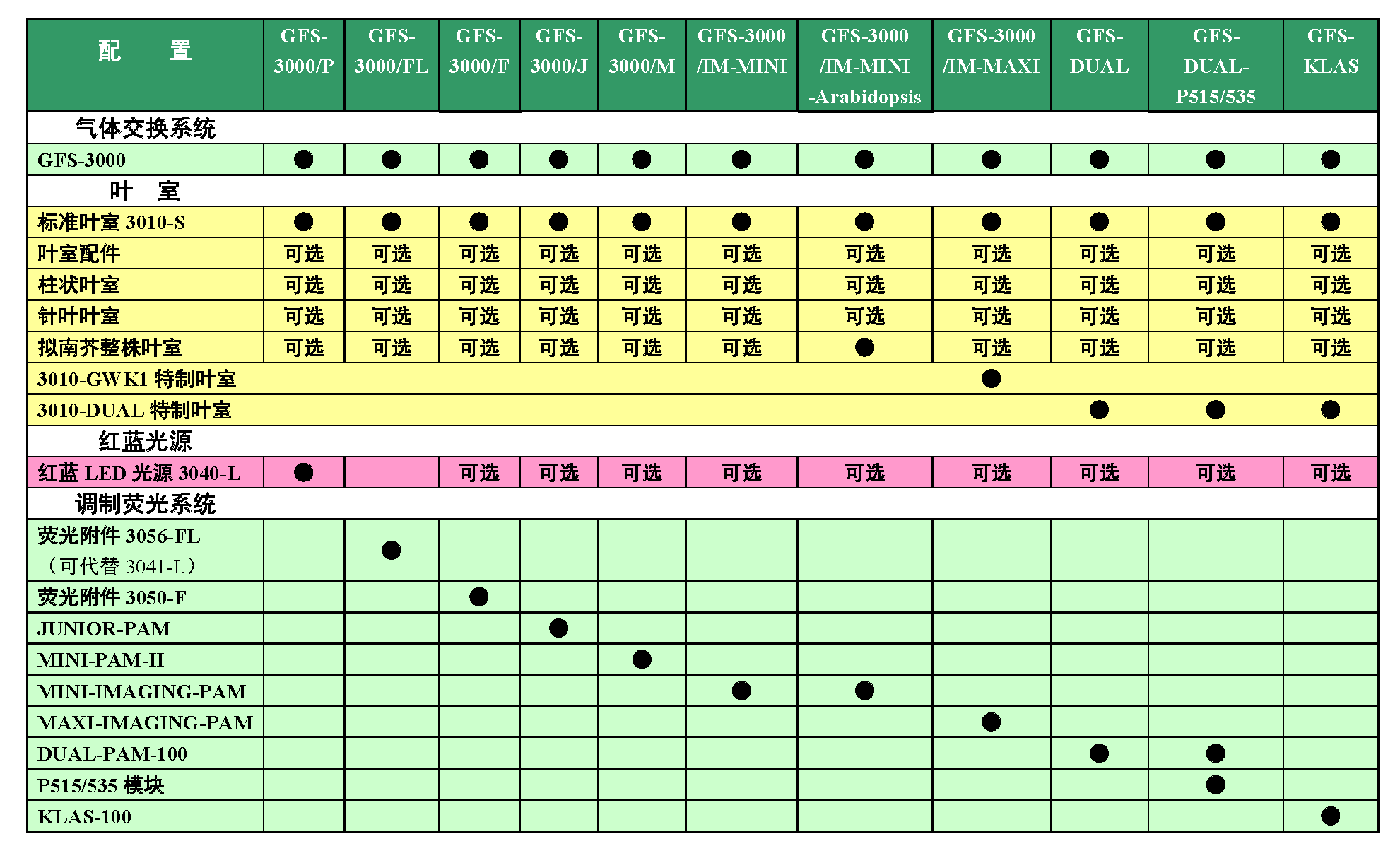 |
產(chǎn)地:德國 WALZ
代表文獻
數(shù)據(jù)來源:光合作用文獻 Endnote 數(shù)據(jù)庫
原始數(shù)據(jù)來源:Google Scholar
1. Abiola, Y. O., et al. (2025). "Contrasting leaf structural, photosynthetic and allocation responses to elevated [CO2] in different-aged leaves of tropical fruit trees Persea americana and Annona muricata." Plant Physiology and Biochemistry: 109842.
2. Ansari, R., et al. (2025). "Photosynthetic efficiency and chlorophyll fluorescence responses of Viola ignobilis Rupr. subjected to different biostimulants and two light intensities." Journal of Horticulture and Postharvest Research: 213-228.
3. Bacalu-Rus, D., et al. (2025). "The Influence of Heavy Metals Contained in Sludge Used as Fertilizer for the Dahlia Variabilis Plant on Photosynthetic Traits." WSEAS Transactions on Environment and Development 21: 417-425.
4. Barboza, L. (2025). "Physiological Impacts of Bemisia Tabaci MEAM1 Infestation on Soybean Cultivars with Different Levels of Resistance." J Environ Pollut 1(1): 01-09.
5. Brodsky, V., et al. (2025). "Acclimation of carbon metabolism to a changing environment across a leaf rosette of Arabidopsis thaliana." Plant Stress: 100958.
6. Castillo, C., et al. (2025). "In vivo transformations of positively charged nanoparticles alter the formation and function of RuBisCO photosynthetic protein corona." Nature Nanotechnology.
7. Chavan, S. B., et al. (2025). "Optimizing tree shade gradients in Emblica officinalis-based agroforestry systems: impacts on soybean physio-biochemical traits and yield under degraded soils." Agroforestry systems 99(1): 21.
8. Contreras-Serrano, M., et al. (2025). "Increased Growth Temperatures Alter Arctic Plant Responses to Heat Wave and Drought." Global change biology 31(4): e70187.
9. Copaciu, F., et al. (2025). "Enhancing UV-B Protection and Abiotic Stress Tolerance in Tomato Plants: The Role of Silicon Nanoparticles in Photosynthetic Parameters, Pigments, and Secondary Metabolite Production." Plants 14(16): 2599.
10. D’Angieri, M., et al. (2025). "Sulfur supply and ammonium toxicity affect photosynthesis and plant nutrition in Tanzania guinea grass." Theoretical and Experimental Plant Physiology 37(1): 39.
11. de Farias, R. M., et al. (2025). "Physiology, biochemistry and yield of melon in a semi-arid region with the application of biostimulants1." Brazilian Journal of Agricultural and Environmental Engineering 29(1): e283055.
12. Diao, H., et al. (2025). "Contrasting photosynthetic, stomatal and mesophyll mechanisms drive common reductions in leaf water-use efficiency under blue light." Journal of Experimental Botany.
13. Dziubek, D., et al. (2025). "Dissection of photosynthetic short and long-term acclimation to fluctuating light reveals specific functions within the chloroplast thioredoxin network." Journal of Experimental Botany.
14. Fan, B., et al. (2025). "Different water and photosynthetic resource use strategies explain the widespread distribution of Dasiphora fruticosa in Qinghai-Tibet Plateau alpine meadows." Environmental and Experimental Botany 231: 106106.
15. Fateminia, F., et al. (2025). "Effects of gamma-aminobutyric acid, melatonin, and potassium phosphite on the growth and photosynthetic efficiency of Citrus aurantium L. seedling." Journal of Plant Process and Function 13(64): 49-60.
16. Gómez-Gallego, M., et al. (2025). "Light Limitation and Foliar Pathogenic Infection Impact Phloem Anatomy and Function in Pinus radiata D. Don." Plant, Cell & Environment n/a(n/a).
17. Gu, L., et al. (2025). "Regulatory Coordination of Photophysical, Photochemical, and Biochemical Reactions in the Photosynthesis of Land Plants." Plant Direct 9(5): e70080.
18. Guo, L., et al. (2025). "Salt-alkali-tolerant growth-promoting Streptomyces sp. Jrh8-9 enhances alfalfa growth and resilience under saline-alkali stress through integrated modulation of photosynthesis, antioxidant defense, and hormone signaling." Microbiological Research 296: 128158.
19. Hartwig, R. P., et al. (2025). "Drought response of the maize plant-soil-microbiome system is influenced by plant size and presence of root hairs." Annals of Botany.
20. Jia, Y., et al. (2025). "Endophytic fungi enhance drought tolerance in Fagopyrum tataricum: Insights into flavonoid biosynthesis and photosynthetic pathways." Agricultural Water Management 313: 109496.
21. Jiang, J., et al. (2025). "Livestock and poultry manure influence thallium accumulation in chili peppers (Capsicum annuum) under complex toxic elements contamination in soil." Journal of hazardous materials 482: 136605.
22. Kang, J., et al. (2025). "TAC-C uncovers open chromatin interaction in crops and SPL-mediated photosynthesis regulation." Science Advances 11(22): eadu6565.
23. Khan, A., et al. (2025). "Mitochondria-mediated retrograde responses evoked by inhibitor antimycin A and mtDNA elimination in Chlamydomonas reinhardtii." International Journal of Biological Macromolecules: 144690.
24. Lehr, P. P., et al. (2025). "Guard Cell-Specific Metabolic Responses to Drought Stress in Maize." Journal of Agronomy and Crop Science 211(2): e70049.
25. Lehr, P. P., et al. (2025). "Sulfate enhances metabolic acclimation under drought stress – a comparative study of grapevine and maize." Plant Stress: 100938.
26. Li, Q., et al. (2025). "Correlation Analysis of Twig and Leaf Characteristics and Leaf Thermal Dissipation of Hippophae rhamnoides in the Riparian Zone of the Taohe River in Gansu Province, China." Plants 14(2): 282.
27. Li, Y., et al. (2025). "Impacts of non-steroidal anti-inflammatory drugs on Phragmites australis root exudation throughout plant life cycle: Defense responses and phytoremediation potential." Journal of Environmental Sciences.
28. Li, Z., et al. (2025). "Continuous Cropping Duration Alters Green Pepper Root Exudate Composition and Triggers Rhizosphere Feedback Inhibition." Agronomy 15(8): 2010.
29. Lima, J. V. L., et al. (2025). "Synergistic Effect of Exogenous Application of Proline and Boric Acid on the Growth, Physiological Aspects, and Postharvest Quality of Radish under Salt Stress." ACS Omega.
30. Lima, V. F., et al. (2025). "The fern Nephrolepis exaltata is largely unresponsive to climate change conditions at both physiological and metabolic levels." The Plant Journal 123(3): e70397.
31. Lin, S., et al. (2025). "Hydrogen sulfide improves photosynthetic efficiency by regulating light energy dissipation and reversible phosphorylation of thylakoid proteins in rice under salt stress." Plant Physiology and Biochemistry: 109908.32. Liu, J., et al. (2025). "Anthocyanins promote the abundance of endophytic lactic acid bacteria by reducing ROS in Medicago truncatula." The Plant Journal 122(1): e70127.
33. Liu, W., et al. (2025). "The role of the sucrose synthase gene in promoting thorn occurrence and vegetative growth in Lycium ruthenicum." Plant Molecular Biology 115(1): 30.
34. Luo, Y., et al. (2025). "Effect of the fungal endophyte Epichlo? sinensis on the physiology of different Festuca sinensis ecotypes under salt-alkaline treatment." Plant and Soil.
35. Ma, X., et al. (2025). "Influences of environmental and leaf functional traits variations on photosynthetic characteristics of Cotoneaster multiflorus in Xinglong Mountain." Frontiers in Plant Science Volume 16 - 2025.
36. Mao, H.-T., et al. (2025). "Chlorophyll b is essential for the growth, photoprotection, and photosystem I assembly in wheat." The Plant Journal 123(4): e70442.
37. Marcelino, R. M. d. S., et al. (2025). "Salicylic acid mitigates damage caused by water deficit in forage sorghum1." Brazilian Journal of Agricultural and Environmental Engineering 29(3): e286824.
38. Márquez, D., et al. (2025). "Navigating Challenges in Interpreting Plant Physiology Responses through Gas Exchange Results in Stressed Plants." Plant Ecophysiology.
39. Ormond, A., et al. (2025). "The trade-off between photosynthetic rate and thallus moisture-demand explains lichen habitat association with the temperate rainforest." Oecologia 207(3): 48.
40. Osipova, S. V., et al. (2025). "Drought tolerance of the photosynthetic apparatus of bread wheat (Triticum aestivum L.) lines with introgressions in chromosome 2D from Aegilops tauschii Coss." Vavilovskii Zhurnal Genet Selektsii 29(4): 530-538.
41. Pappert, I., et al. (2025). "Effects of high light intensity and spectral variability on maize photosynthesis and growth." Frontiers in Plant Science 16.
42. Perez, R., et al. (2025). "A Comprehensive Database of Leaf Temperature, Water, and CO 2 Fluxes in Young Oil Palm Plants Across Diverse Climate Scenarios."
43. Qu, Y., et al. (2025). "Identification and characterization of compounds that improve plant photosynthesis and growth under light stress conditions." Communications Biology 8(1): 300.
44. Schober, T., et al. (2025). "The effects of plant density and duration of vegetative growth phase on agronomic traits of medicinal cannabis (Cannabis sativa L.): A regression analysis." PLoS ONE 19(12): e0315951.
45. Schuler, P., et al. (2025). "PANDA: A simple and affordable chamber system for measuring the whole-plant net CO2 flux." bioRxiv: 2025.2006. 2002.657330.
46. Seydel, C., et al. (2025). "Subcellular plant carbohydrate metabolism under elevated temperature." Plant Physiology.
47. Shi, Q., et al. (2025). "Optimising Peanut Growth: Exogenous Calcium Enhances Photosynthesis in Phosphorus-Limited Environments." Plant, Cell & Environment n/a(n/a).
48. Silva, A. G. C. d., et al. (2025). "Methyl jasmonate as an attenuator of salt stress on the morphophysiological aspects of red rice." Rev. bras. eng. agríc. ambient 12(29).
49. Silva, A. G. C. d., et al. (2025). "Methyl jasmonate as an attenuator of salt stress on the morphophysiological aspects of red rice1." Brazilian Journal of Agricultural and Environmental Engineering.
50. Sommer, N., et al. (2025). "The potential of four legume trees for mercury phytoremediation and the role of arbuscular mycorrhizal fungi."
51. Takeuchi, K., et al. (2025). "PSII Photoinhibition as a Protective Strategy: Maintaining an Oxidative State of PSI by Suppressing PSII Activity Under Environmental Stress." Physiologia plantarum 177(4): e70392.
52. Th?lix, L., et al. (2025). "Carbon sequestration in different urban vegetation types in Southern Finland." Biogeosciences 22(3): 725-749.
53. Trinh, M. D. L., et al. (2025). "Chloroplast envelope-localized DLDG1 modulates H+ translocation across thylakoid membranes via plastidial ATP synthase." Plant Physiology.
54. Wang, Y., et al. (2025). "Photosynthetic Characteristics and Leaf Structure of Yellow-leafed Lilium davidii Var. unicolor." HortScience 60(4): 587-600.
55. Wegher, M., et al. (2025). "Impact of leaf removal on recovery of young grapevines under heatwave conditions: A study in an ecotron environment." OENO One 59(3).
56. Wei, G., et al. (2025). "Chloride Application Enhances Photosynthesis and Facilitates Nitrate Translocation While Driving Chloride Translocation Into Roots." Food and Energy Security 14(3): e70095.
57. Wu, D., et al. (2025). "Supplementary Calcium Overcomes Nocturnal Chilling-Induced Carbon Source-Sink Limitations of Cyclic Electron Transport in Peanuts." Plant, Cell & Environment n/a(n/a).
58. Wu, R., et al. (2025). "Rhizophagus intraradices enhances soybean tolerance to soda saline-alkaline stress through coordinated regulation of ionic homeostasis and photosynthetic efficiency during critical growth stages." Plant Physiology and Biochemistry: 110382.
59. Wu, R., et al. (2025). "Rhizophagus irregularis combined with biochar enhances Cr tolerance in Ricinus communis by altering host plant's antioxidant and photosynthetic characteristics." Industrial Crops and Products 227: 120769.
60. Yongxing, Z., et al. (2025). "夾沙分層配土條件下紫花苜蓿的光合及蒸騰特性研究." Guan'gai Paishui Xuebao= Journal of Irrigation and Drainage 44(4): 47.
61. Zhang, X., et al. (2025). "Effects of litter layer alterations caused by increasing stand age on the seed germination and seedling establishment of Robinia pseudoacacia plantations." Forest Ecology and Management 594: 122960.
62. Zhang, Y.-L., et al. (2025). "Trees use exogenous sugars for growth, but excess triggers negative feedback reducing photosynthetic carbon gain." Tree physiology.
